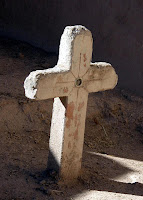Between 700 and 1300 AD, the Anasazi Pueblo Indians cultivated the Chaco Civilization in Chaco Canyon making it the center of the Anasazi civilization. Visiting here one can see the dramatic adobe dwellings, or pueblos the Anasazi (a Navajo word meaning "ancient ones" or possibly "ancient enemies") built.
 The pueblos were built or shaped with a straw-and-mud plaster, a typical architectural seen today in the Southwest. These pueblos often rose four to five stories high, an astonishing accomplishment for the time. The dwellings had rooms surrounding a central plaza, and throughout the settlement a number of kivas, meeting places that served a ceremonial purpose. This architecture blended harmoniously with the surrounding landscape with the doors, exterior posts and window frames painted to match the bright blue sky and the brown building the color of the earth. The population of a pueblo might have been around 1,200 people.
The pueblos were built or shaped with a straw-and-mud plaster, a typical architectural seen today in the Southwest. These pueblos often rose four to five stories high, an astonishing accomplishment for the time. The dwellings had rooms surrounding a central plaza, and throughout the settlement a number of kivas, meeting places that served a ceremonial purpose. This architecture blended harmoniously with the surrounding landscape with the doors, exterior posts and window frames painted to match the bright blue sky and the brown building the color of the earth. The population of a pueblo might have been around 1,200 people.Between 1200 –1500 Pueblo Indians established villages along the Rio Grande and its tributaries. The northernmost of New Mexico's 19 pueblos, the Taos Pueblo has been home to the Tiwa tribes for more than 900 years, and appears the same as it did when Coronado’s expedition came in 1540. Though the Tiwa were essentially a peaceful agrarian people, they are perhaps best remembered for spearheading the only successful revolt by Native Americans in history. Launched by Pope (Poh-pay) in 1680, the uprising drove the Spanish from Santa Fe until 1692 and from Taos until 1698.
Pueblos welcome visitors to observe their annual events: The turtle dance on New Year's Day, deer or buffalo dances on Three Kings Day (Jan 6), and corn dances on Santa Cruz Day (May 3), San Antonio Day (June 13), San Juan Day (June 24), Santiago Day (July 25), and Santa Ana Day (July 26). The annual Taos Pueblo Powwow, a dance competition and parade that brings together tribes from throughout North America, is held the second weekend of July on tribal lands off NM 522. The pueblo Christmas celebration begins on Christmas Eve, with bonfires and a procession with children's dances. On Christmas day, the deer or Matachine dances take place.
Acoma Pueblo - Also called Sky City.
Chaco Canyon Pueblos - Ancient pueblos are preserved at Chaco Canyon
Cochiti Pueblo - is the home of Helen Cordero, who created the first storyteller figurines.
Isleta Pueblo New Mexico - . Also called Tuei.
Jemez Pueblo New Mexico - Wala-towa and home to the Peco Pueblo descendants
Laguna Pueblo New Mexico - Ka-waikah or Pueblo of the Lake People.
Nambe Pueblo New Mexico - Nambe Pueblo, New Mexico is 18 miles north of Santa Fe. Near Nambe Falls Recreation
Picuris Pueblo New Mexico - We-Lai. Highlights include the 200-year-old San Lorenzo Mission
Pojoaque Pueblo New Mexico - pronounced Po-Joageh, is home to the Poeh Museum.
San Felipe Pueblo - Koots-cha.
San Juan Pueblo - Its Tewa name is Ohkay Oweenge.
Sandia Pueblo - Na-fiat.
Santa Ana Pueblo - Tamaya.
Santa Clara Pueblo - includes the Puye Cliff Dwellings. Also called Kha 'Po.
Santo Domingo Pueblo - Santo Domingo is famous for their jewelry and closely guarded and maintained culture.
Taos Pueblo - Taos Pueblo is the largest surviving multistoried Pueblo structure in the United States.
Zia Pueblo - The Zia's Sun Symbol is the official state insignia that appears on the flag
Pueblo Secrecy wonder why the Pueblos are so secretive, there's good reason. Read about their history of religious persecution.







